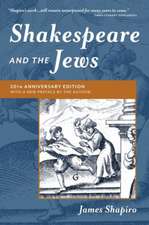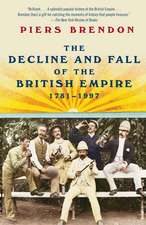Oberammergau: The Troubling Story of the World's Most Famous Passion Play
Autor James Shapiroen Limba Engleză Paperback – 31 mai 2001
Preț: 97.34 lei
Nou
Puncte Express: 146
Preț estimativ în valută:
18.63€ • 19.52$ • 15.40£
18.63€ • 19.52$ • 15.40£
Carte disponibilă
Livrare economică 21 martie-04 aprilie
Preluare comenzi: 021 569.72.76
Specificații
ISBN-13: 9780375708527
ISBN-10: 0375708529
Pagini: 272
Ilustrații: 16 PPS B&W PHOTOS (20 HALFTONES)
Dimensiuni: 132 x 203 x 15 mm
Greutate: 0.25 kg
Editura: Vintage Books USA
ISBN-10: 0375708529
Pagini: 272
Ilustrații: 16 PPS B&W PHOTOS (20 HALFTONES)
Dimensiuni: 132 x 203 x 15 mm
Greutate: 0.25 kg
Editura: Vintage Books USA
Notă biografică
James Shapiro is a professor of English and comparative literature at Columbia University. The author of Shakespeare and the Jews, he lives in New York City and Thetford, Vermont.
From the Hardcover edition.
From the Hardcover edition.
Extras
Preface
Oberammergau is justly celebrated as one of the few places in the world where theater still matters. Communal and personal identity have become inextricably bound to the Passion play that has been staged in this village, generation after generation, since 1634, and probably longer. Over the past four centuries, millions of visitors have traveled to Oberammergau to see these villagers reenact the suffering, Crucifixion, and Resurrection of Jesus, and most have left profoundly moved by the experience.
Oberammergau is also notorious for staging a play -- praised by Hitler himself and sharply attacked by Jewish organizations -- that has long portrayed Jews as bloodthirsty and treacherous villains who conspire to kill Jesus. That it is performed in the country responsible for the Holocaust has only intensified this criticism.
As a theater historian I found myself fascinated by the ways in which the tradition of Passion playing in Oberammergau was rooted in the world of medieval and Renaissance drama. But as someone who also writes and teaches about the interplay of art and anti-Semitism, I was disheartened by the ways in which this unbroken tradition had helped sustain the troubling legacy of medieval anti-Judaism. Like Shakespeare's The Merchant of Venice, Richard Wagner's music, and Ezra Pound's Cantos, the Oberammergau play appeared to be one of those works of art whose virtues were deeply compromised.
In 1998 I learned that the villagers had voted to let reformers -- rather than traditionalists -- direct their Passion play in the year 2000. I had also heard that these reformers were interested in ridding the play of its anti-Jewish elements. The questions swirling around the Oberammergau Passion play were ones that I had long been wrestling with: Should offensive art be censored or boycotted? Why did the reconciliation of Jews and Catholics set in motion by Vatican II seem to have ground to a halt? How was one to deal with mutual accusations of collective guilt: that the Jews (as the Passion play had long maintained) were responsible for the death of Jesus, and that the German people were collectively responsible for the Holocaust?
The making of the millennial production of Oberammergau's Passion play offered a rare opportunity to confront these issues directly.
From the Hardcover edition.
Oberammergau is justly celebrated as one of the few places in the world where theater still matters. Communal and personal identity have become inextricably bound to the Passion play that has been staged in this village, generation after generation, since 1634, and probably longer. Over the past four centuries, millions of visitors have traveled to Oberammergau to see these villagers reenact the suffering, Crucifixion, and Resurrection of Jesus, and most have left profoundly moved by the experience.
Oberammergau is also notorious for staging a play -- praised by Hitler himself and sharply attacked by Jewish organizations -- that has long portrayed Jews as bloodthirsty and treacherous villains who conspire to kill Jesus. That it is performed in the country responsible for the Holocaust has only intensified this criticism.
As a theater historian I found myself fascinated by the ways in which the tradition of Passion playing in Oberammergau was rooted in the world of medieval and Renaissance drama. But as someone who also writes and teaches about the interplay of art and anti-Semitism, I was disheartened by the ways in which this unbroken tradition had helped sustain the troubling legacy of medieval anti-Judaism. Like Shakespeare's The Merchant of Venice, Richard Wagner's music, and Ezra Pound's Cantos, the Oberammergau play appeared to be one of those works of art whose virtues were deeply compromised.
In 1998 I learned that the villagers had voted to let reformers -- rather than traditionalists -- direct their Passion play in the year 2000. I had also heard that these reformers were interested in ridding the play of its anti-Jewish elements. The questions swirling around the Oberammergau Passion play were ones that I had long been wrestling with: Should offensive art be censored or boycotted? Why did the reconciliation of Jews and Catholics set in motion by Vatican II seem to have ground to a halt? How was one to deal with mutual accusations of collective guilt: that the Jews (as the Passion play had long maintained) were responsible for the death of Jesus, and that the German people were collectively responsible for the Holocaust?
The making of the millennial production of Oberammergau's Passion play offered a rare opportunity to confront these issues directly.
From the Hardcover edition.
Recenzii
“Compelling.... Even-handed.... Shapiro exposes the basic human desire to rewrite the past.”–San Francisco Sunday Examiner & Chronicle
“Deftly melds the ancient disciplines of theater and theology with contemporary ethnic politics.”–Newsday
“Deftly melds the ancient disciplines of theater and theology with contemporary ethnic politics.”–Newsday
















